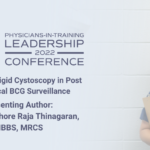Abstract | April 4, 2022
Flexible vs Rigid Cystoscopy in Post Intravesical BCG Surveillance
Learning Objectives
- Choose the best modality for cystoscopic surveillance of post intravesical BCG therapy bladders��.
Background: Intravesical BCG instillation is an established form of immunotherapy for intermediate and high risk bladder cancers. Mandatory cystoscopic surveillance is commonly performed under general anaesthesia (GA), to facilitate biopsy or other procedures. However, it is resource-intensive with unclear clinical benefit.
We performed a two-cycle audit, before and after changing post-BCG surveillance policy, from GA cystoscopy to Local Anaesthetic Flexible Cystoscopy (LAFC) on Trans Urethral Laser Ablation (TULA) lists, where patients may undergo a tumour biopsy or laser ablation.
Methods and Patients: In first cycle we audited 53 patients undergoing 114 post-BCG rigid cystoscopies from January 2018 to December 2019 . In second cycle there were 56 patients undergoing 99 post-BCG LAFC on TULA lists in 2020.
Results: In the first audit cycle cohort, mean patient age was 72.29±8.98, 48 were men; malignant histology was identified only on five occasions (three grade progressions). 14 patients required overnight admission. In the second audit cycle cohort, mean patient age was 70.44±9.17, 47 were men. Four had a grade progression while another had a stage progression. Out of 99 LAFC, 47 confirmed normal bladder appearance. A biopsy was taken during other 52 cystoscopies: 17 (33%) confirmed malignancy. 15 patients showed findings which were labelled as recurrence but only two required a further GA procedure to deal with recurrence. One patient was admitted for post-procedure bleeding, which settled with irrigation.
Conclusion: Local anaesthetic TULA procedure is a safe and effective alternative for a general anaesthetic rigid cystoscopy to survey bladders of patients after BCG therapy.

